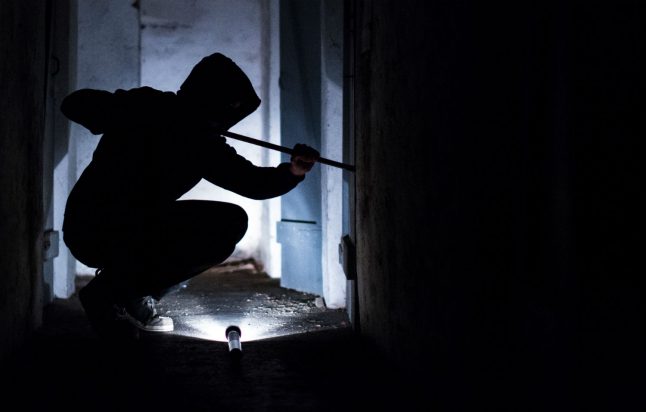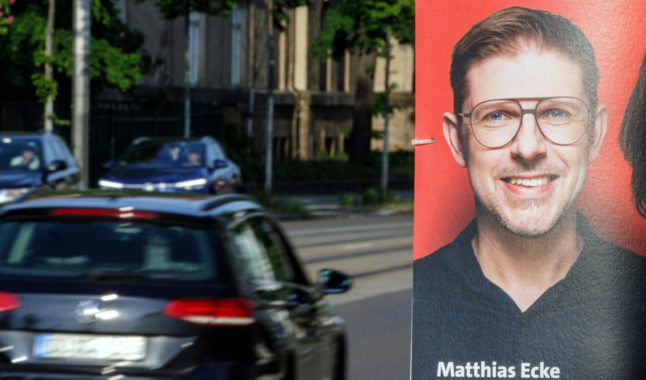The state with the highest number of break-ins in 2017 was Germany’s most populated state of North Rhine-Westphalia, where 39,057 incidents were recorded for approximately 18 million residents and eight million households. It’s a giant dip from 52,578 break-ins the year before.
“We would assume that the noticeable difference is due to a combination of preventative measures and better protection of our citizens,” police spokesperson Frank Federau told The Local.
Yet the second highest number occurred in Germany’s fourth most populated state of Lower Saxony (approximately eight million residents), with a total of 13,595 break ins, down from 16,405 incidents the year before.
The third highest number took place in Berlin, with 8,580 attempted and completed incidents out of its 3.6 million residents. This also represents a significant drop from the year before, in which 11,507 break-ins occurred.
The number of home break-ins throughout Germany has decreased in every state in 2017 as compared to 2016. The same holds true on a five year scale – 2017 versus 2013, with the exception of Saxony (4,071 break-ins in 2017 versus 3,620 in 2013). The number of breaks in throughout the country reached an all-time high in 2015, or 167,136 cases versus 149,500 the year before.
(Scroll over the maps to see the exact numbers of attempted and successful burglaries)
if(“undefined”==typeof window.datawrapper)window.datawrapper={};window.datawrapper[“3bJkq”]={},window.datawrapper[“3bJkq”].embedDeltas={“100″:480,”200″:427,”300″:400,”400″:400,”500″:400,”700″:400,”800″:400,”900″:400,”1000”:400},window.datawrapper[“3bJkq”].iframe=document.getElementById(“datawrapper-chart-3bJkq”),window.datawrapper[“3bJkq”].iframe.style.height=window.datawrapper[“3bJkq”].embedDeltas[Math.min(1e3,Math.max(100*Math.floor(window.datawrapper[“3bJkq”].iframe.offsetWidth/100),100))]+”px”,window.addEventListener(“message”,function(a){if(“undefined”!=typeof a.data[“datawrapper-height”])for(var b in a.data[“datawrapper-height”])if(“3bJkq”==b)window.datawrapper[“3bJkq”].iframe.style.height=a.data[“datawrapper-height”][b]+”px”});
Different shades of protection for different states
The decrease in burglaries in Germany can be partially attributed to a stricter law that was enacted in the summer in 2017: burglars would be imprisoned for a minimum sentence of one year – with the steepest sentence behind bars stretching to 10 years – versus the previous six months.
German states also took greater preventative measures, particularly in educating citizens about ways to better protect their homes against burglars. They included everything from providing information about locks and alarms, to simply giving a nudge to make sure that doors and windows are shut properly during the night.
“Through in person consultations at local police stations, we reach many people who often better protected their home ownership. We publish public press releases and are in dialogue with citizens. There are flyers, media campaigns, etc,” said Federau.
This helped stop burglars in their tracks: in North Rhein Westphalia in 2017, 46.3 percent of the 39,057 registered apartment break ins didn’t make it past the initial stages, for example, due to a second window or door getting in the way, or an alarm going off.
Police also turned to social media. In 2017, police in Berlin, Baden-Württemberg and Saxony tweeted live about break-ins under the hashtag #keinbruch to sensitize the public for the topic and prevention. Break-ins have also gone down in wealthy Baden-Württemberg in southwest Germany, with 8,437 in 2017 compared with 12,225 in 2016.
if(“undefined”==typeof window.datawrapper)window.datawrapper={};window.datawrapper[“3bJkq”]={},window.datawrapper[“3bJkq”].embedDeltas={“100″:480,”200″:427,”300″:400,”400″:400,”500″:400,”700″:400,”800″:400,”900″:400,”1000”:400},window.datawrapper[“3bJkq”].iframe=document.getElementById(“datawrapper-chart-3bJkq”),window.datawrapper[“3bJkq”].iframe.style.height=window.datawrapper[“3bJkq”].embedDeltas[Math.min(1e3,Math.max(100*Math.floor(window.datawrapper[“3bJkq”].iframe.offsetWidth/100),100))]+”px”,window.addEventListener(“message”,function(a){if(“undefined”!=typeof a.data[“datawrapper-height”])for(var b in a.data[“datawrapper-height”])if(“3bJkq”==b)window.datawrapper[“3bJkq”].iframe.style.height=a.data[“datawrapper-height”][b]+”px”});
if(“undefined”==typeof window.datawrapper)window.datawrapper={};window.datawrapper[“3bJkq”]={},window.datawrapper[“3bJkq”].embedDeltas={“100″:480,”200″:427,”300″:400,”400″:400,”500″:400,”700″:400,”800″:400,”900″:400,”1000”:400},window.datawrapper[“3bJkq”].iframe=document.getElementById(“datawrapper-chart-3bJkq”),window.datawrapper[“3bJkq”].iframe.style.height=window.datawrapper[“3bJkq”].embedDeltas[Math.min(1e3,Math.max(100*Math.floor(window.datawrapper[“3bJkq”].iframe.offsetWidth/100),100))]+”px”,window.addEventListener(“message”,function(a){if(“undefined”!=typeof a.data[“datawrapper-height”])for(var b in a.data[“datawrapper-height”])if(“3bJkq”==b)window.datawrapper[“3bJkq”].iframe.style.height=a.data[“datawrapper-height”][b]+”px”});
if(“undefined”==typeof window.datawrapper)window.datawrapper={};window.datawrapper[“3bJkq”]={},window.datawrapper[“3bJkq”].embedDeltas={“100″:480,”200″:427,”300″:400,”400″:400,”500″:400,”700″:400,”800″:400,”900″:400,”1000”:400},window.datawrapper[“3bJkq”].iframe=document.getElementById(“datawrapper-chart-3bJkq”),window.datawrapper[“3bJkq”].iframe.style.height=window.datawrapper[“3bJkq”].embedDeltas[Math.min(1e3,Math.max(100*Math.floor(window.datawrapper[“3bJkq”].iframe.offsetWidth/100),100))]+”px”,window.addEventListener(“message”,function(a){if(“undefined”!=typeof a.data[“datawrapper-height”])for(var b in a.data[“datawrapper-height”])if(“3bJkq”==b)window.datawrapper[“3bJkq”].iframe.style.height=a.data[“datawrapper-height”][b]+”px”});
Preventative policing
Many states have turned to software which analyzes the likelihood of break-ins in specific areas so that they can take preventative measures. They either create their own, or utilize technology from manufacturers such as IBM, Microsoft or the Institute for Pattern-Based Forecasting Technology (IfmPt).
The Bavarian police, in particular, are devout users of this technology, having defined 47 areas in which computers calculate the risk of burglars striking based on their previous missions. Policemen analyze the data on a daily basis and hand out orders to their colleagues, who patrol the areas. Their data collection seems to have worked, as the number of burglaries in Bavaria was 6,045 in 2017, compared to 7,470 in 2016.
In Berlin, which uses a software called KrimPro, it also seems to have worked to reverse the burglary trend – after a sharp spike starting 12 years ago. The number of burglaries doubled “explosively” between 2006 and 2011, from 6,000 to 12,000, according to former Interior Senator Frank Henkel.
But since then, the Christian Democratic politician has said that he’s seen a “cautious trend reversal”: By July of 2017, 6,690 burglaries had been reported, back at the same numbers from a decade before despite the city swelling significantly in population.
A reason for future worry?
With preventative measures going up, citizens’ worries are going down. According to a survey released jointly from YouGov and dpa earlier this year, 20 percent of respondents had a greater fear of burglaries than any other sort of crime, down from 26 percent when surveyed on the same topic in December 2015.
In June, U.S. President Donald Trump again generated controversy when he claimed that crime had shot up by 10 percent due to immigration in the country.
Yet according to the Federal Crime Office, the majority of incidents are committed by German nationals and ‘regional local perpetrators’, such as youth gangs and drug users. However, the Crime Office also states that break-ins from travelling perpetrators are on the rise, the majority who come from southern and eastern Europe.



 Please whitelist us to continue reading.
Please whitelist us to continue reading.
My bitcoin was hacked very recently, there was no customer support to talk to about it. i was in real issues, debt and unpaid bills. till i met someone that helped me out. I will love to tell you more about how i recovered my bitcoin anonymously. you can check out darkwebsolutions dot co on how i recovered my bitcoin, they also helped with an app to monitor my kids movements to make sure they were safe all the time. They are the real deal